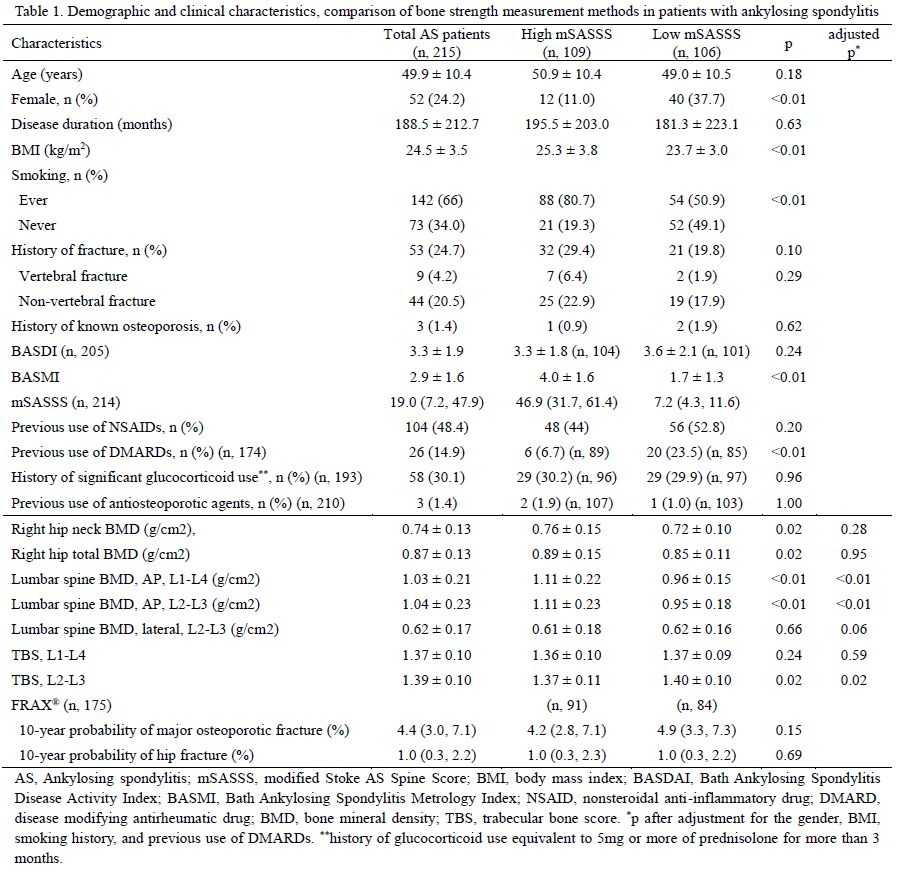Session Information
Session Type: ACR Poster Session C
Session Time: 9:00AM-11:00AM
Background/Purpose: Ankylosing spondylitis (AS) is a disease characterized by spinal osteoproliferation (syndesmophytosis) and the general trabecular bone loss with increased fracture risk. Syndesmophyts in spine leads overestimation of the anteroposterior (AP) lumbar spine BMD measured by dual-energy X-ray absorptiometry (DXA) which is a gold standard of diagnostic tool for osteoporosis. Thus, more accurate fracture risk assessment tool is needed in AS patients.
Objectives: We aimed to compare various fracture risk assessment tools according to modified Stoke AS Spine Score (mSASSS), and to identify the tool which can best reflect the risk of fracture in AS patients.
Methods: Total of 215 AS patients were enrolled from a single university hospital in Korea. Demographic and clinical information was collected by questionnaires and physical exams. They completed simple X-ray of L-spine, AP and lateral BMD by DXA. FRAX was measured and TBS was obtained from DXA using TBS iNsight software. Quantification of spine ankyloses were determined by mSASSS. We classified patients into two groups: 1) high mSASSS group with mSASSS ¡Ã19, which is median value of study population, and 2) low mSASSS group with mSASSS <19. We compared the clinical characteristics and facture risk assessment tools between two groups. In addition, fracture risk assessment tools were compared according to history of fracture, which is known to be the strongest risk factor for fracture, using ANCOVA.
Results: The 109 patients (50.7%) were classified to high mSASSS group. Female patients were more in low mSASSS group (p<0.01), and smoking history were more prevalent in high mSASSS group (p<0.01). L-spine lateral BMD and TBS were lower, while right hip and L-spine AP BMD were significantly higher in high mSASSS group. After adjustment, mean TBS of L2-L3 was significantly lower and L-spine AP BMD was significantly higher in high mSASSS group (p=0.02 and p<0.01, respectively). Total 53 patients (24.7 %) had fracture history of any type. Patients with fracture history showed higher 10-year probability of major osteoporotic fracture by FRAX¢ç (p=0.01) and lower TBS of L2-L3 in patients with fracture history (p=0.04 after adjustment).
Conclusion: TBS was lower in patients with advanced syndesmophytes, and it was significantly associated with history of fracture. TBS can be a useful method in measuring bone strength and also predicting fracture risk in AS patients.
To cite this abstract in AMA style:
Nam SW, Sung YK, Kim D, Cho SK, Song Y, Choi YY, Kim TH. The Usefulness of Trabecular Bone Score in Assessing the Bone Strength and Fracture Risk of Patients with Ankylosing Spondylitis [abstract]. Arthritis Rheumatol. 2017; 69 (suppl 10). https://acrabstracts.org/abstract/the-usefulness-of-trabecular-bone-score-in-assessing-the-bone-strength-and-fracture-risk-of-patients-with-ankylosing-spondylitis/. Accessed .« Back to 2017 ACR/ARHP Annual Meeting
ACR Meeting Abstracts - https://acrabstracts.org/abstract/the-usefulness-of-trabecular-bone-score-in-assessing-the-bone-strength-and-fracture-risk-of-patients-with-ankylosing-spondylitis/


